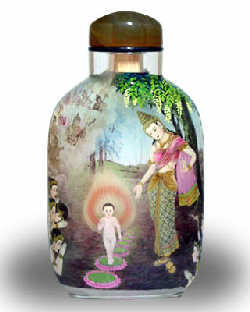 Formation
Formation
 Interior paintings of various shapes and patterns are made of glass, crystal, agate, etc, through carving and grinding. Using a special paintbrush, the artists paint the inside of a bottle through a narrow mouth, incorporating the whole process of composition, delineation, wrinkle removal and coloring. Unlike traditional painting techniques where the artist begins with the background and moves outwards, the interior-painting artist must paint the foreground first. Such talented artists must study for many years to become masters.
Interior paintings of various shapes and patterns are made of glass, crystal, agate, etc, through carving and grinding. Using a special paintbrush, the artists paint the inside of a bottle through a narrow mouth, incorporating the whole process of composition, delineation, wrinkle removal and coloring. Unlike traditional painting techniques where the artist begins with the background and moves outwards, the interior-painting artist must paint the foreground first. Such talented artists must study for many years to become masters.
There is a legend about the formation of interior painting. In the late years of the Qinglong Period in the Qing Dynasty, a minor provincial official went to town on business. As an upright official, the man aspired to achieve his ends the honest way. However, due to the low efficiency of the state government and shortage of bribes to related officials, his business was delayed time and time again. Without money or food, the official used a tobacco pick to scrape the inside of his snuff bottle when his supply was running low, leaving many nicks and scratches on the inside of the bottle. His snuff bottle caught the eyes of a conscientious monk, who later painted the inside of snuff bottles using a bent and tipped bamboo pick and ink. And this is how this peculiar painting technique emerged.
In the early stages of interior bottle painting, since there were no transparent glass bottles and the inside walls were very sleek, only a few simple pictures could be painted, such as grasshoppers, cabbages, phoenixes and simple landscapes. Later on, craftsmen learned how to fill the bottle with water, iron sand and emery, making the inside walls like Xuanpaper-- delicate but not sleek. As a result, artists could paint the insides of bottles with great detail, and snuff bottles were later developed into a kind of artwork featuring a combination of poetry and painting.
